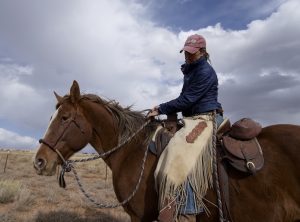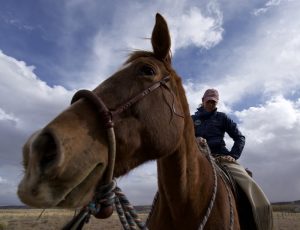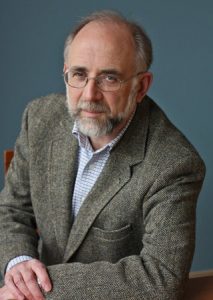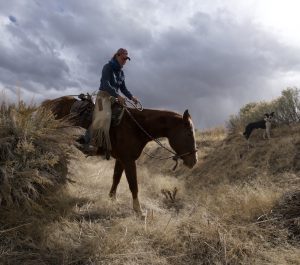The world will never starve for want of wonders; but only for want of wonder.
Gilbert Keith Chesterton, 1874-1936
Maddy Butcher writes:
Like you, I’m curious. New information around horses fascinates me. Sure, I have the natural skepticism of a journalist. But when insights clarify and help improve our connection with horses, I’m all for it.

PC: Beau Gaughran
Ten years ago, I caught the neuroscience bug. What I learned while helping Dr. Steve Peters and Martin Black with Evidence-Based Horsemanship undoubtedly improved my horse work. My subsequent research for Horse Head: Brain Science & Other Insights did so as well.
Now, though, I’m seeing brain science in a new light. No longer do I see it as the most essential know-how for a horse owner’s educational toolbox. Like a doctor’s assessment of one’s physical self, it’s just one part of a much bigger picture.
What we know about horse brain science – that licking and chewing is a parasympathetic response, that dwell times enable faster learning, that consistent dopamine-related experiences can build optimal learning patterns – helps us see what’s going on and can hasten our progress. No doubt. But in focusing too narrowly on neuroscience, we run the risk of missing other, equally vital components of the horse’s development. We can neglect considering its overall well-being, its body, its life.

PC: Beau Gaughran
Sure, it’s helpful to zoom in to see the horse at a molecular, neurochemical level. But it’s equally valuable to pan out for the big picture.
Before the 2019 Best Horse Practices Summit, I was chatting with keynote speaker, Steve Budiansky, about the other presentations. I mentioned brain science. There was an audible pause. Do you have reservations about that, I asked? He said something about it being a bit reductionist and we moved on.
Recently, I got back in touch with Budiansky and asked him to elaborate. (Reductionism, in case you were wondering, is the practice of describing complex phenomena in simplified terms.)
He writes:
I am in general a great friend of reductionism, but I think it’s a well-established rule that trying to understand any system as complex as animal behavior always demands multiple levels of explanation.

Steve Budiansky
It’s certainly true that all animal behavior is fundamentally neuroanatomy—but that’s also trivial and it doesn’t really help us in itself to build up a useful picture of what’s going on. The way neuroanatomy is expressed in behavior is constantly limited and channeled and shaped by learning, environment, social interactions, all of which have their useful concepts and terminology that help us make sense of what’s going on and why, and understanding how horses learn and react to different situations.
You could similarly say that all you need to do to win at chess is to know the rules of how the pieces move. True enough, but it doesn’t get you too far.
I’m reminded of a typical summer scene in which I move through a gate to halter one of my horses. Yes, I’m watching for brain-science markers that can tell me how my horses are feeling. But I am also watching how they situate themselves among their herd mates, how the flies are aggravating them, when they last ate, etc.
As students of the horse, we must cultivate our holistic awareness. We need to recognize that neuroscience, physiology, herd dynamics, fitness, digestive health all matter and all merit study. There are myriad elements in any horse-human equation. Some we can quantify, some float under our radar.
Are we aware of how much our presence impacts the horse? What about our neurology? What about how we treated the horse in the past? What about our fitness and mental health?
A friend of mine, who went to college and received his PhD in human sciences, is getting fed up with Western medicine. (Defined here as a system in which medical doctors treat symptoms and diseases using drugs, radiation, surgery, etc.) Eastern Medicine, on the other hand, treats the whole person, encouraging a healthy body to prevent illness and speed recovery.

PC: Beau Gaughran
My friend quoted Victor Hugo, who said, “Science has the first word on everything, and the last word on nothing.”
I think he has a point. Science helps us see things from a focused, hyper-informed perspective. It often gives us a brilliant new lens through which to interpret behaviors, interactions, and experiences. But if we fail to appreciate the whole person, the whole horse, the whole environment, the whole moment, we can get into trouble.
Said Budiansky:
I worry especially about the potential for mischief (and voodoo) in encouraging people to think you can leap from a few measures of the physiology of the nervous system to horsemanship.
Neuroanatomy is very helpful in showing us what’s wrong with certain ideas about training or horse behavior. But there’s no magic shortcuts, and that’s what I think we need to be on guard against.
Enjoy your horsemanship journeys and stay curious.
I find this article to be an affirmation during my journey as a student of the horse. Horses are incredible at “speaking” to us – by all manor of behavior. If we want to be better caretakers of our relationship with the horse, we need to look at all aspects of the horse, the whole horse. As a Equine Gestalt Coach student, I’m also realizing how well horses open those buried things that humans are so good at hiding, even from themselves. They help us look at the whole person as well. Some may think it’s a symbiotic relationship, but for both species, we need each other more than we want to admit.
Thank you for sharing.
Thanks, Carolyne. Very thoughtful comments.
I love this. I have read both “Evidence Based Horsemanship” and “The Nature of Horses”, and devoured the science; but the overwhelming lesson of my time with horses is how far our relationships with them can surpass the data. I believe horses live in the place every wisdom tradition of the world urges us toward; a place of presence, awareness, non-judgement. As we reach for our horses, it’s best to communicate on their terms; and when we do, we find ourselves experiencing our own world in a much richer way. As Carolyne says above, when we let them, they show us things we didn’t even know were there. I believe my horses have helped me move toward greater mindfulness, and I believe they have made me a better human because of it.
Nice thoughts, Stephanie. Thanks for adding to the conversation.
There are a lot of layers when it comes to the horse. When I read your writing, I thought, ‘exactly’. Good one, Mads. K
Interesting, I personally don’t know any horsefolks who have focused TOO heavily on the neuroscience. If they are out there, and it is negatively effecting their work in some way, I would be interested to know how that manifests. Or not. If anything, I still see lots of people moving faster themselves (both physic-all and mentally) than the horse can learn, despite what the human has learned. If nothing else, understanding more about (how going slowly) makes learning happen is THE puzzle piece I seek. But I do have a background in the sciences, so I consider the bias here.
Even without that, knowing some factual aspects of the nature of the ANS, important ways we can understand neurotransmitters in ourselves and our horses….ahh…that is like magic to me…you know, as they say, Science, is like magic, only real. And I am sticking to it, with no hyper focus, but as a puzzle piece for my big picture.
Great article!! I love the Victor Hugo quote. The tendency to tunnel vision without opening our lens up again never serves us well.
Your end quote from Budiansky, “Neuroanatomy is very helpful in showing us what’s wrong with certain ideas about training or horse behavior. But there’s no magic shortcuts, and that’s what I think we need to be on guard against.” says it all for me.
I am a professional dog trainer, and I do work with horses too, both wild and domestic, in both the wild and in companion homes. In both cases, that is the one thing that is the bane of my work, that people expect magic shortcuts. We absolutely need to be on guard against this no matter the species. Humans love magic shortcuts. It is what we seek everywhere in life! It is the hardest thing to get across to humans, that we need to slow down and consider the other life form we are working with. We need to stop bulldozing whatever is in our paths. From colonialism to our insane consumption habits, we destroy everything in our paths in the name of progress.
When we slow down, and we take the time to observe, practice mindfulness, and learn, so much real magic happens!
its incredible how closely you can connect to the horses even down to the flies bugging them and herd behavior especially with such an incredible animal